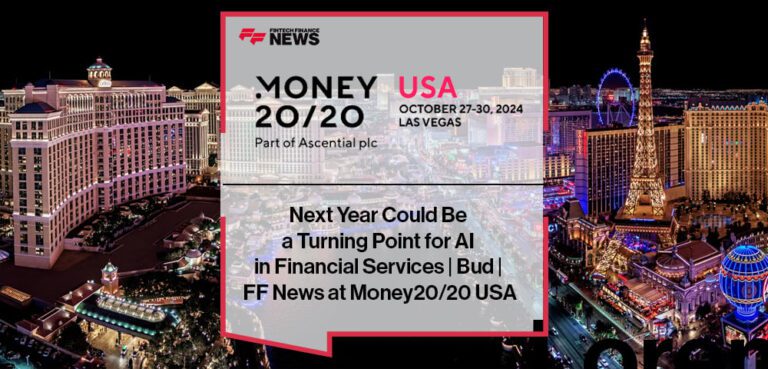Focus on AI.
At Money20/20 we spoke to Ed Maslaveckas, CEO of Budwho shared trusted and bold insights into the transformative potential of AI in financial services.
While acknowledging the hype, he highlights how it can help and adds to the growing anticipation that the technology could actually add a lot of value to the industry by 2030. We’re also hearing about the emerging role of “agentic AI” that goes beyond recommendations to perform actions on users’ behalf and the potential for fintechs to leapfrog traditional banks in adopting these tools.
One thing is certain, 2025 will be a turning point.
Maslaveckas isn’t afraid to share bold predictions, as we discovered when we featured Bud in the latest edition of Paytech Magazine. You can read the full article here. Here he adds more information on the current state of AI with a focus on both immediate applications and the next frontier:Agentic AI.
A balanced view of AI hype and reality
There’s no doubt that there’s a lot of hype around AI, particularly generative AI, but while AI’s entry into the mainstream is exciting, Maslaveckas highlights how It is important to recognize the long-standing role of machine learning (ML) and neural networks in finance. services. For example, Bud developed a transaction enrichment language model as early as 2018, demonstrating that fundamental applications of AI have been in use for years.
But what cannot be ignored is that there are some truly impactful AI use cases that could have a huge impact on the banking industry. According to the McKinsey Global Institute (MGI), Gen AI could add between 200 billion dollars and $340 billion in annual value to the global banking sector. These use cases include personalization, segmentation, and process optimization.
In the interview above, he candidly points out that banks are fundamentally driven by numbers. AI systems excel at processing and understanding these data-intensive operations, so they are bound to play a role. He also highlighted the value of AI tools to improve workflows, describing Bud’s data analytics product, which automates data tasks to augment human capabilities rather than replacing them.
What’s Next for Agentic AI
One of the key messages here concerns the distinction between “agent” and “agentic” AI models. Agents, such as today’s conversational AI, interpret user input and provide recommendations. Agentic models, however, go even further by performing actions on behalf of users, such as transferring funds, requesting financial products, or optimizing account settings.
Maslaveckas paints a striking picture of the potential of agent banking to revolutionize customer engagement. Bud has been making his own moves in the agent banking space and he discusses their own product. Imagine AI proactively identifying the best mortgage rates, optimizing your credit card choices, or automating tedious administrative tasks like switching service providers.
“The biggest problem in financial services is customer apathy,” explained Ed. By removing the friction of manual intervention, agentic AI can enable users to effortlessly act on financial opportunities.
Although agent systems can streamline workflows and reduce manual errors, their deployment carries higher risks due to regulatory complexity. It therefore encourages banks to adopt this paradigm while recognizing that fintech companies could be quicker to adapt and capitalize on their agentic capabilities.
The competitive landscape: banks versus fintechs
Drawing parallels with the rise of neobanks like Monzo and Revolut, Maslaveckas also suggests that agentic AI could catalyze a similar wave of disruption in the Gen AI space. Fintechs, thanks to their agility and innovation, could outpace traditional banks in adopting these tools, especially as data becomes the keystone of competitive advantage. He welcomed open banking frameworks in the UK, such as app-to-app consent flows, to make data sharing transparent and foster trust.
However, he also noted that the particular dynamics of the U.S. market could lead to even faster innovation. Unlike the UK, where financial engagement tends to lag, US customers are more proactive. Combined with the presence of tech giants like Google and a robust ecosystem of data companies, the United States could soon get a head start in delivering cutting-edge AI experiences.
We also get some important thoughts on the disconnect between AI advances and regulatory frameworks. Financial services are subject to strict compliance requirements, which can slow AI adoption.
A year of transformation ahead
Bud has come a long way and Maslaveckas describes how far the industry has come and how AI could play a crucial role in its future. “Everyone is gearing up,” he notes, adding that although the business results are not yet clear, the groundwork done today will bear fruit in the years to come.
As Bud continues to innovate in the field of agentic AI, Ed remains optimistic about its ability to transform not only the customer experience but also the operational fabric of banks. The big question, he concludes, is whether traditional institutions can evolve quickly enough to remain competitive, or whether fintechs will seize the opportunity to lead the next banking era.
There is no doubt in his mind that AI is not just a trend: it will revolutionize the future of financial services.

